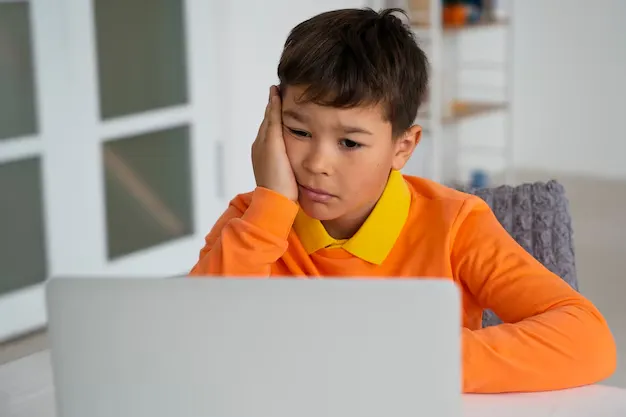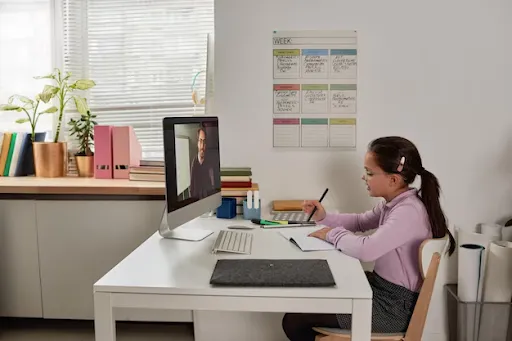Children's Eye Health
How Screen Time Affects Children's Academic Performance
FSDAVCFEBFEVSDDVFSD
FSDAVCFEBFEVSDDVFSD
FSDAVCFEBFEVSDDVFSD
Impact of Screen Time on Learning
Excessive screen time can harm children's academic performance by causing digital eye strain, reduced attention spans, and difficulty concentrating on schoolwork. Studies reveal that children who spend more than two hours daily on screens may face declines in reading comprehension and problem-solving abilities. Overexposure to screens can also disrupt sleep patterns, further affecting cognitive function and school performance.
Parents can address these challenges by encouraging regular screen breaks and fostering outdoor activities to promote balance. Creating screen-free zones at home helps establish healthier habits, enhancing children's focus and productivity. With mindful strategies, parents can support their children's well-being and academic success.
Excessive screen time can harm children's academic performance by causing digital eye strain, reduced attention spans, and difficulty concentrating on schoolwork. Studies reveal that children who spend more than two hours daily on screens may face declines in reading comprehension and problem-solving abilities. Overexposure to screens can also disrupt sleep patterns, further affecting cognitive function and school performance.

Parents can address these challenges by encouraging regular screen breaks and fostering outdoor activities to promote balance. Creating screen-free zones at home helps establish healthier habits, enhancing children's focus and productivity. With mindful strategies, parents can support their children's well-being and academic success.

The Link Between Eye Health and Academics
Children's eye health plays a crucial role in their academic success. Extended screen use often leads to digital eye strain, manifesting as dry eyes, headaches, and blurred vision. These discomforts can hinder a child's ability to concentrate during lessons or homework, directly affecting their learning and performance. Over time, if not managed, digital eye strain can contribute to more severe vision problems that further impact their education and overall well-being.
Regular eye exams are vital in safeguarding children's eye health. These check-ups can help identify and address vision issues early, enabling timely interventions that enhance focus and academic achievement. For children already using corrective lenses, periodic exams ensure their prescriptions remain up to date, preventing unnecessary strain. Early detection of potential vision challenges empowers children to perform their best both inside and outside the classroom.
Parents can also adopt preventive measures to reduce screen-related eye strain. One effective strategy is the 20-20-20 rule: every 20 minutes of screen time, children should take a break to look at something 20 feet away for at least 20 seconds. Encouraging outdoor play and reducing non-essential screen time further supports healthier vision. By prioritizing eye care, parents can help their children thrive academically and protect their long-term eye health.
Tips to Manage Screen Time

Effectively managing screen use can significantly enhance children’s academic performance. Setting clear time limits is an essential first step. Depending on the child's age, screen use should ideally be restricted to one to two hours per day. Parental control settings can help enforce these limits, ensuring a balanced approach to screen time. Additionally, teaching children to take regular breaks during study sessions or recreational screen use is crucial. Encouraging them to follow the 20-20-20 rule (look at something 20 feet away for 20 seconds every 20 minutes) can reduce digital eye strain and maintain focus.

Optimizing screen settings is another practical strategy. Adjusting screen brightness to match ambient lighting and using blue light filters can minimize eye strain and improve comfort during prolonged use. These small but impactful measures empower parents to create a healthier digital environment, supporting their children’s academic success and overall well-being.
Implementing effective screen time management strategies can greatly reduce the negative impact of excessive device use on children’s learning and overall well-being. Establishing clear time limits based on age is a crucial first step. For instance, restricting recreational screen use to one or two hours daily allows children to strike a balance between digital activities and other essential tasks. Parents can further support this by enabling parental controls to monitor and manage screen usage effectively. Encouraging regular breaks, such as the 20-20-20 rule (look at something 20 feet away for 20 seconds every 20 minutes), can alleviate digital eye strain and help children maintain focus.
Additionally, creating a screen-friendly environment can make a significant difference. Adjusting screen brightness to align with ambient lighting and applying blue light filters reduces visual discomfort and promotes healthier screen habits. Parents should also encourage outdoor activities and non-digital hobbies, which not only provide a break from screens but also foster creativity and physical health. By adopting these strategies, parents can proactively mitigate the adverse effects of screen time, ensuring their children develop healthy habits that enhance their learning, productivity, and overall quality of life.
The Role of Regular Eye Exams
Regular eye exams are essential for identifying and managing vision problems related to screen use. Early detection of issues like myopia or digital eye strain can prevent these conditions from negatively impacting a child’s academic performance. At Kleinwood Vision, we specialize in comprehensive pediatric eye care, ensuring your child’s eyes remain healthy and their vision supports their learning and daily activities.
Scheduling annual eye exams is a proactive step in safeguarding your child’s vision health. If your child is showing signs of digital eye strain, such as headaches, dry eyes, or difficulty focusing, consulting an optometrist can provide tailored solutions. Options like prescription glasses with blue light filters or lifestyle adjustments, such as reducing screen time and encouraging frequent breaks, can make a significant difference. Prioritize your child’s eye health today to set the foundation for clear vision and academic success in the future.
Creating a Screen-Friendly Study Environment
A well-organized study environment plays a crucial role in reducing the negative impact of screen time on children. Proper lighting in the study area helps minimize screen glare, which can strain the eyes. Positioning digital devices at eye level ensures better posture, reducing neck and eye strain, while ergonomic seating adds to overall comfort during extended study sessions.
Parents can support their children by encouraging the use of screens primarily for educational purposes during study time. This focused approach not only helps children remain attentive but also reduces unnecessary exposure to digital distractions. Regular breaks from screens further enhance productivity and eye health.

A well-organized study environment plays a crucial role in reducing the negative impact of screen time on children. Proper lighting in the study area helps minimize screen glare, which can strain the eyes. Positioning digital devices at eye level ensures better posture, reducing neck and eye strain, while ergonomic seating adds to overall comfort during extended study sessions.
Parents can support their children by encouraging the use of screens primarily for educational purposes during study time. This focused approach not only helps children remain attentive but also reduces unnecessary exposure to digital distractions. Regular breaks from screens further enhance productivity and eye health.
By incorporating these adjustments, parents can create a healthier and more conducive study environment. These simple yet effective strategies help protect children’s vision while supporting their academic performance and overall well-being.
By incorporating these adjustments, parents can create a healthier and more conducive study environment. These simple yet effective strategies help protect children’s vision while supporting their academic performance and overall well-being.
The Importance of Balance
Balancing screen time with other activities is vital for supporting children’s academic success and overall well-being. Excessive use of digital devices can negatively impact physical activity, creativity, and social interactions. Encouraging children to participate in outdoor play, sports, or creative pursuits like art and music can help reduce their reliance on screens. These activities not only promote physical health but also foster cognitive and emotional growth.
Quality family time is another effective way to counterbalance screen use. Shared activities such as playing board games, cooking, or enjoying nature walks can strengthen family bonds and reduce screen dependency. These moments of connection are essential for children’s emotional well-being, helping them develop stronger relationships and better communication skills.
It’s important to recognize that limiting screen time doesn’t mean eliminating it completely. Digital devices can be valuable for learning and entertainment when used in moderation. Parents can set clear boundaries by establishing designated times for screen use and ensuring a balance between screen-based and non-screen activities. This approach teaches children the importance of managing their time effectively and responsibly.
By fostering a balanced approach to screen time, parents can support their children in achieving improved academic performance, better physical health, and more fulfilling social lives. Encouraging diverse activities alongside setting healthy limits allows children to enjoy the benefits of digital technology while avoiding its drawbacks. Building this balance is a proactive way to ensure children grow up with the skills and habits needed for lifelong success and well-being.
Encouraging Healthy Screen Habits

Establishing healthy screen habits early on can have long-term benefits for children’s academic performance and overall well-being. One effective strategy is modeling good behavior. When parents limit their own screen use and focus on engaging activities, children are more likely to follow suit. This sets a positive example and reinforces the importance of maintaining a balanced lifestyle.
Creating tech-free zones in the home is another impactful step. Designate spaces like the dining room or bedrooms as areas where screens are not allowed.
Establishing healthy screen habits early on can have long-term benefits for children’s academic performance and overall well-being. One effective strategy is modeling good behavior. When parents limit their own screen use and focus on engaging activities, children are more likely to follow suit. This sets a positive example and reinforces the importance of maintaining a balanced lifestyle.
Creating tech-free zones in the home is another impactful step. Designate spaces like the dining room or bedrooms as areas where screens are not allowed. This encourages meaningful interactions during meals and promotes better sleep hygiene by reducing late-night exposure to screens. These spaces can become safe havens for relaxation and family bonding.
Prioritizing sleep is crucial for children’s health and focus. Encourage screen-free time at least an hour before bedtime to improve sleep quality. These simple but effective changes can significantly enhance how children use screens, boosting their focus and academic success.
This encourages meaningful interactions during meals and promotes better sleep hygiene by reducing late-night exposure to screens. These spaces can become safe havens for relaxation and family bonding.
Prioritizing sleep is crucial for children’s health and focus. Encourage screen-free time at least an hour before bedtime to improve sleep quality. These simple but effective changes can significantly enhance how children use screens, boosting their focus and academic success.
Key Takeaways
Understanding the impact of screen time on children’s academic performance is crucial for parents aiming to support their child’s success. Excessive screen use can lead to digital eye strain, reduced focus, and sleep disturbances, all of which negatively affect learning. By managing screen time effectively and incorporating regular breaks, parents can help mitigate these risks. Encouraging a balanced lifestyle that includes physical activity, hobbies, and quality family time further supports children’s cognitive and emotional well-being, promoting better academic outcomes.
Regular eye exams are vital for identifying and addressing any vision issues early on. At Kleinwood Vision, we specialize in comprehensive pediatric eye care and offer tailored advice to ensure your child’s eyes remain healthy. From detecting early signs of myopia to providing solutions for digital eye strain, our team is here to help protect your child’s vision and enhance their learning experience. Together, we can set the foundation for their success.

Contact Info
Hours of Operation
Mon - Fri | 9:00 AM - 5:00 PM
Sat - Sun | Closed
Holiday Hours: We are closed for the following holidays: New Years Day, Memorial Day, Independence Day, Labor Day, Thanksgiving Day, Christmas Day
© 2025 Kleinwood Vision. All rights Reserved.


